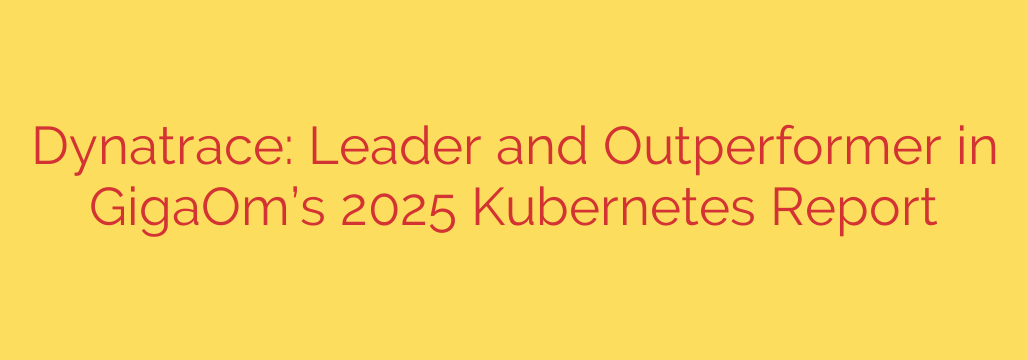
Mastering Kubernetes: Why a Unified, AI-Powered Observability Platform is a Game-Changer
Kubernetes has firmly established itself as the engine of modern cloud-native applications. Its power to orchestrate containers at scale is undeniable, but this power comes with a significant challenge: overwhelming complexity. As environments grow with countless microservices, pods, and dependencies, traditional monitoring tools begin to fail, leaving DevOps and SRE teams drowning in data but starved for answers.
The days of juggling separate tools for logs, metrics, traces, and security are over. The sheer volume and dynamic nature of Kubernetes environments demand a more intelligent and integrated approach. The future—and the solution to this complexity—lies in unified observability platforms that leverage the power of artificial intelligence.
The Core Challenge: Finding the Signal in the Noise
In a distributed Kubernetes environment, a single user request can trigger a cascade of events across dozens of services. When something goes wrong, identifying the root cause can feel like searching for a needle in a haystack.
Teams are often faced with:
- Alert Storms: Traditional tools trigger a flood of disconnected alerts, making it impossible to prioritize or understand the primary issue.
- Data Silos: Metrics are in one system, logs in another, and security scans in a third. Manually correlating this data during an outage is slow, stressful, and inefficient.
- Visibility Gaps: It’s difficult to see the full picture, from the end-user experience all the way down to the underlying infrastructure and specific lines of code.
This fractured approach doesn’t just slow down troubleshooting; it hinders innovation and increases business risk.
The Solution: A Unified Platform Approach
Leading-edge solutions are now defined by their ability to provide a single source of truth for all performance and security data. By bringing everything under one roof and applying intelligence, these platforms transform observability from a reactive chore into a proactive advantage.
Here are the key characteristics of a modern, best-in-class observability platform for Kubernetes:
1. AI-Powered Root-Cause Analysis
The most significant leap forward is the use of causal AI. Instead of just showing you a dashboard of what is broken, an AI engine can automatically analyze all related dependencies and data points in real-time.
This powerful capability pinpoints the precise root cause of a problem, complete with its business impact, eliminating hours of guesswork and war-room calls. It moves your team from asking “what happened?” to instantly knowing “why it happened.”
2. Full-Stack, End-to-End Visibility
True observability requires a holistic view. A unified platform provides deep insights across every layer of your environment. This includes the ability to:
- Trace transactions from the user’s click on a mobile app or browser.
- Follow the request through every microservice and container.
- Connect application performance directly to the underlying Kubernetes infrastructure, including nodes, pods, and network performance.
This seamless, contextual view ensures there are no blind spots, allowing teams to optimize performance and troubleshoot issues anywhere in the stack.
3. Built-in Security and DevSecOps Enablement
In the modern landscape, observability and security are two sides of the same coin. A forward-thinking platform doesn’t treat security as an add-on but bakes it directly into the observability fabric.
This means providing automated, real-time vulnerability detection at runtime and protecting applications from threats from the inside out. By providing security context directly alongside performance data, these platforms empower DevSecOps initiatives and help teams “shift left,” addressing security concerns early in the development lifecycle.
4. Seamless Integration with Open Standards
A powerful platform shouldn’t be a walled garden. It must embrace the open-source ecosystem that modern development teams rely on. Support for standards like OpenTelemetry is crucial, allowing organizations to ingest data from any source while still benefiting from the platform’s advanced AI and automation capabilities. This provides maximum flexibility without sacrificing intelligence.
Actionable Security Tips: Choosing Your Kubernetes Observability Tool
When evaluating a solution to manage your Kubernetes environment, look beyond basic dashboards. Ask these critical questions:
- How much automation does it provide? Look for solutions that offer automatic discovery, instrumentation, and dependency mapping. The less manual configuration required, the better.
- Does it provide context or just data? A flood of metrics is useless. The platform must be able to connect the dots between application performance, user experience, security vulnerabilities, and business outcomes.
- Is security an integrated feature? Ensure the platform offers runtime application security and vulnerability analysis, not just post-scan reports. Security must be a real-time, integrated part of your operational view.
- Can it scale with your environment? The solution must be able to handle the massive scale and dynamic nature of enterprise-grade Kubernetes without performance degradation.
The Future is Unified and Intelligent
As organizations continue to rely on Kubernetes to drive digital transformation, the need for a sophisticated observability strategy has never been more critical. Moving away from fragmented, legacy tools toward a unified, AI-powered platform is no longer a luxury—it’s essential for maintaining performance, securing applications, and enabling your teams to innovate with confidence.
Source: https://datacenternews.asia/story/dynatrace-named-leader-outperformer-in-2025-gigaom-report-on-kubernetes








